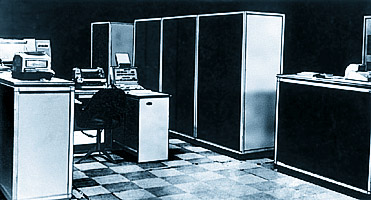Digital Electronic Computer 'MINSK-32'
Home → Articles → Minsk Family of Computers → Digital Electronic Computer “MINSK-32”
Gennadiy Dmitrievich Smirnov, Anatoliy Vikentevich Gerkovich, Yuri Vladimirovich Karpilovic

- Chief designer: V.V. Przhijalkovskiy,
Main designers: G.D. Smirnov, V.J. Pykhtin, Y.G. Bostanjyan, N.A. Maltsev, M.E. Neneman. - Developing organization: Special Design Bureau of G.K. Ordzhonikidze computing machines plant in Minsk. Subjected to the USSR Ministry of Radio producing industry.
- Manufacturing plant: Minsk, G.K. Ordzhonikidze computing machines plant. The USSR Ministry of Radio producing industry.
- Finishing of design phase: 1968
- Beginning of serial production: 1968
- Finishing of serial production: 1975
- Application field: Computer “Minsk-32” was the most numerous soviet electronic computing machine of the second generation. This computer was widely used in the soviet industry and national economy, most of the computing centres were equipped with those machines. At the Budapest 1972 regular session of the (East Europe) Counsil of Mutual Economic Assistance computer “Minsk-32” was adopted as the basic one for the Automatic Control Systems organization and development in the East Europe.
- Number of manufactured computers — 3000 pieces
Description of the Computer (structure, architecture including peripheral units)
Unit construction of the computer allowed to assemble different configurations. The 37-places long word and the 7-places long symbol were used in “Minsk-32” as informational units. The word was used for storing of the command and operational information, the symbol — for the work with fields of variable length and processing of information arrays of the peripheral devices.
The basic set of “Minsk-32” devices included: computing unit (arithmetic device, central logic unit, exchange unit, magnetic operating memory device -RAM- for 32 K-words, power supply device, central control panel and broad selection of various information storage, input and output devices).
Universal communication system of the computer enabled additional direct connection of the computing unit with: fast channel — up to 3 groups 8 devices in each; with slow channel — 4 devices. There was a logical possibility of connecting 96 devices. The basic set later could be extended by additional connection of RAM units with total capacity of 32 K-words.
Basic Components
Semiconductor devices P-416 (П416), diode-transphormer valves. Clock-rate — 600 KHz.
Design
Blocks, assembling universal cabinet of extruded profile. Autonomous testing of single devices enabled organization of assembly-line production.
Technology
Number of progressive technological processes was implemented. That was the first time in electronic production practice, when assembly of a computer was performed on a conveyor assembly line. Bench maintenance equipment was widely used for assembly quality control: wire identification station for assembled units, which was designed at the plant's own automation and mechanisation department. Implementation of the designed bench equipment allowed changing of the complex computer testing for single units control and adjustment; the complex (integral) control was performed only at each tenth computer for general technological process performance control.
Synthetic materials and section-shaped constructions, as well as foundry casting works and press forming were widely used. As the result production of framed structures came into flow-line production. That was also the first successful implementation of magnetic reading heads manufacturing technology. Implementation of new technologies and development of technological constructions enabled flow-line production and made possible manufacturing of large series.
Essential contribution to development of new technologies was made by M.F. Chalaydyuk, N.K. Kovtun, I.V. Matishev, A.P. Lopachenok, S.A. Slavin, etc.
Software
ССК and macros, COBOL, FORTRAN with debuggers, autocode AKI, the first implementation of multiprogramming mode in operational systems of the small computers, the first hard-and-soft compatibility system supporting compatibility on machine programs/software level and possibility of using and processing MINSK-22 software on computer MINSK-32 what sufficiently accelerated implementation of the new model and beginning of its usage in the national economy.
Technical and operational characteristics
- Average performance – 30.000 ops
- RAM capacity –16384+6536 words,
- ROM capacity – 88.000.000 7-bit symbols
Specific features of the computer
Big capacity of operational memory (up to 65536 words of 37-decimal places); multiprogram operation possibility; two communication channels could provide simultaneous connection with 136 peripheral devices, based on universal principles; “Minsk-32” had a fast channel providing possibility to connect external memory devices, such as: magnetic tapes, magnetic drums and magnetic discs; there was possibility of the central logic unit and peripheral devices - fast and slow channels, simultaneous operation; compatibility with computer “Minsk-22M” - “Minsk-32 could process and perform all programs of “Minsk-22M” and the autocode ACI based programs for “Minsk-2” and “Minsk-22” without additional re-programming; addressing possibility for each alpha-numerical symbol in the computer memory, what enabled organization of character-oriented information processing; possibility of computation in decimal system; hard-and-soft time service; two computers collaboration possibility. That time those possibilities of “Minsk-32” were new and implemented first time; they were protected with numerous author's certificates (Soviet analogue of patents).
Sources: (used literature)
- V.V. Przhijalkovaskiy, G.D. Smirnov, N.A. Maltsev, et al. Universal digital computing machine. A.c. 226281, 01.03.67.
- G.D. Smirnov, V.P. Kachkov. Control device of digital computer. А. с. 224159, 15.03.65.
- V.J. Pykhtin, V.J. Evreinov, G.P. Lopato, G.D. Smirnov, A.N. Vasilevskiy, V.N.Khoroshevskiy, V.V.Przhijalkovskiy. Coupling device for computers. А. с. 215596, 09.04.66.
- G.P. Lopato, G.D. Smirnov, V.J. Pykhtin, A.P. Zapolskiy. Homogeneous computing system with distributed memory. А. с. 328465, 12.11.71.
Translated by A. Nitussov



